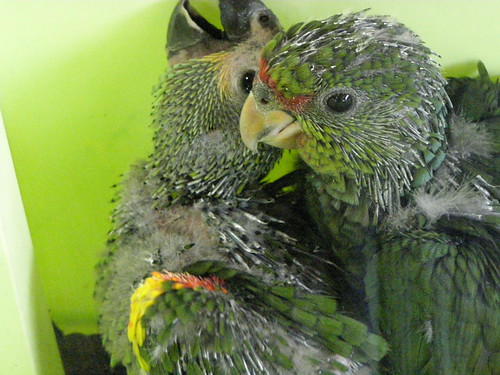Unequal distribution of sons and daughters in Amazon parrots
 Saturday, October 31, 2015 at 9:30
Saturday, October 31, 2015 at 9:30  What is the sex ratio of the amazon parrot you breed? Image by Frank WoutersIn many bird species, the proportion of sons and daughters (offspring sex ratio) can strongly deviate from the expected 50:50. This phenomenon has been observed in domestic species, e.g. chicken, quail, and pigeons, but also in wild species, such as gulls or parrots. Evolutionary theory predicts, that under certain circumstances mothers will gain an advantage by producing a biased offspring sex ratio, for example, when the chances to reproduce differs between the sexes. Still, the underlying mechanisms leading to a biased offspring sex ratio are largely unknown. Research suggests, that the body condition and the hormonal status of the breeding female is of high relevance.
What is the sex ratio of the amazon parrot you breed? Image by Frank WoutersIn many bird species, the proportion of sons and daughters (offspring sex ratio) can strongly deviate from the expected 50:50. This phenomenon has been observed in domestic species, e.g. chicken, quail, and pigeons, but also in wild species, such as gulls or parrots. Evolutionary theory predicts, that under certain circumstances mothers will gain an advantage by producing a biased offspring sex ratio, for example, when the chances to reproduce differs between the sexes. Still, the underlying mechanisms leading to a biased offspring sex ratio are largely unknown. Research suggests, that the body condition and the hormonal status of the breeding female is of high relevance.
Dr. Vivian Goerlich-Jansson (Biologist, Dept. Animals in Science and Society, Utrecht University), started this project after being approached by parrot breeders, noting that Amazon parrots produce biased offspring sex ratios, making future breeding difficult. To find out, whether this is the impression of few or a (worldwide) phenomenon, she and her colleagues, Dr. Yvonne van Zeeland en Dr. Nico Schoemaker, and two enthusiastic students of the CAH Vilentum Dronten set up a questionnaire regarding the circumstances under which Amazon parrots are kept and bred.
The survey takes ca. 30 minutes and is completely anonymous, and your information will be handled with utmost care. If you’re interested in further work, or even collaboration, you can leave your contact details.
https://nl.surveymonkey.com/r/AmazoneE
https://nl.surveymonkey.com/r/Amazonepapegaai (Dutch)
We thank you for your cooperation!

